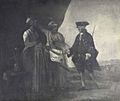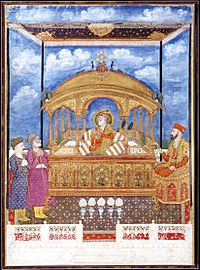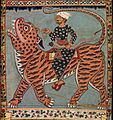Shah Alam II facts for kids
Quick facts for kids Shah Alam II |
|||||
|---|---|---|---|---|---|
| Padishah Al-Sultan Al-Azam |
|||||
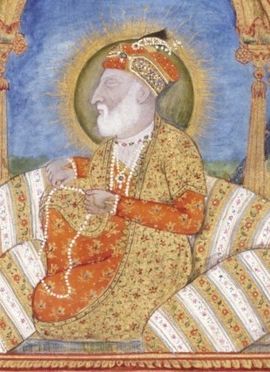
Shah Alam II, after he was blinded in 1788 by Ghulam Qadir
|
|||||
| 17th Mughal Emperor | |||||
| 1st reign | 10 October 1760 – 31 July 1788 | ||||
| Predecessor | Shah Jahan III | ||||
| Successor | Shah Jahan IV | ||||
| 2nd reign | 16 October 1788 – 19 November 1806 | ||||
| Predecessor | Shah Jahan IV | ||||
| Successor | Akbar II | ||||
| Born | Mirza Ali Gauhar 25 June 1728 Shahjahanabad, Subah of Delhi, Mughal Empire (present-day Old Delhi, Delhi, India) |
||||
| Died | 19 November 1806 (aged 78) Shahjahanabad, Subah of Delhi, Mughal Empire |
||||
| Burial | Moti Masjid, Mehrauli, Delhi | ||||
| Spouse |
|
||||
| Issue |
|
||||
|
|||||
| House | House of Babur | ||||
| Dynasty | |||||
| Father | Alamgir II | ||||
| Mother | Zinat Mahal | ||||
| Religion | Sunni Islam (Hanafi) | ||||
| Military career | |||||
| Battles/wars | Third Battle of Panipat Bengal War Battle of Delhi (1764) Battle of Buxar Battle of Delhi (1771) Battle of Delhi (1783) Siege of Delhi (1804) |
||||
Shah Alam II (born Ali Gohar) was the seventeenth Mughal Emperor of India. He was the son of Alamgir II. Shah Alam II became emperor when the Mughal Empire was already losing much of its power. People even had a saying in Persian: Sultanat-e-Shah Alam, Az Dilli ta Palam. This meant 'The empire of Shah Alam is from Delhi to Palam', showing how small his control had become. Palam was just a suburb of Delhi.
Shah Alam faced many attacks, especially from Ahmed Shah Abdali, the ruler of Afghanistan. These attacks led to the Third Battle of Panipat. In this battle, the Maratha Empire fought against the Afghans led by Abdali. The Marathas had a lot of influence over Mughal affairs in Delhi.
In 1760, the Marathas pushed back Abdali's forces. They removed Shah Jahan III, who was a puppet emperor, and made Shah Alam II the rightful emperor. However, Shah Alam II could not return to Delhi until 1772. He came back under the protection of the Maratha general Mahadaji Shinde.
Shah Alam II also fought against the East India Company in the Battle of Buxar. Later, in 1788, he was captured by Ghulam Qadir and was blinded.
Shah Alam II was also a poet. He wrote his own collection of poems called a Diwan, using the pen-name Aftab. He also wrote a famous book called Ajaib-ul-Qasas, which is one of the earliest important prose books in Urdu.
Contents
Early Life of Shah Alam II
Ali Gohar was born on June 25, 1728. His father was Prince Aziz-ud-Din, who later became Emperor Alamgir II. Ali Gohar grew up in the Red Fort in Delhi, almost like a prisoner. However, he was not like other princes who sometimes became lazy. Instead, he was given important jobs when his father became emperor.
When his father became emperor, Ali Gohar became the Wali al-Ahd (Crown Prince). He was his father's main helper, but most of the power was held by the Wazir (chief minister) Imad-ul-Mulk. Ali Gohar had many disagreements with Imad-ul-Mulk. Fearing for his life, he ran away from Delhi in 1758.
Escape from Delhi
Prince Ali Gauhar, who would become Emperor Shah Alam II, was the rightful heir to his father, Alamgir II. His father had been made Mughal Emperor by Vizier Imad-ul-Mulk and a Maratha leader.
Prince Ali Gauhar gathered a small army and bravely escaped from Delhi. In 1759, he went to the eastern parts of the empire. He hoped to gain control over areas like Bengal, Bihar, and Odisha to make his position stronger.
Soon after, Najib-ud-Daula forced Imad-ul-Mulk to leave Delhi. He gathered a large Mughal Army and removed Shah Jahan III, who was not the rightful emperor. Najib-ud-Daula and other Muslim nobles then planned to defeat the Marathas. They worked with the powerful Ahmad Shah Durrani. After Durrani defeated the Marathas, he named Ali Gauhar as the emperor, Shah Alam II.
Bengal War
In 1760, Shah Alam's army gained control of some areas in Bengal, Bihar, and Odisha. Prince Ali Gauhar and his Mughal Army of 30,000 soldiers wanted to remove Mir Jafar and Imad-ul-Mulk. These two had tried to capture or kill him. The conflict soon involved the powerful East India Company.
The Mughals wanted to take back their eastern provinces. Prince Ali Gauhar was joined by other leaders and 200 French soldiers. They fought against the British during the Seven Years' War.
Prince Ali Gauhar marched to Patna and surrounded the city with over 40,000 soldiers. He wanted to capture Ramnarian, an enemy of the Mughals. Mir Jafar was scared and sent his son Miran to help Ramnarian and retake Patna. Mir Jafar also asked Robert Clive for help. Major John Caillaud scattered Prince Ali Gauhar's army in 1761 after four big battles.
After talks for peace, the British helped Shah Alam II meet Mir Qasim, the new Nawab of Bengal. Mir Qasim was made the governor of Bengal, Bihar, and Odisha. He agreed to pay an annual tax of 2.4 million dam to Shah Alam II. Shah Alam II then went to Allahabad and was protected by Shuja-ud-Daula, the Nawab of Awadh, from 1761 to 1764.
Meanwhile, Mir Qasim's relationship with the East India Company got worse. He removed tax benefits for the Company and also removed Ramnarian, an enemy of the Mughal Empire. Mir Qasim also started factories to make Firelock guns for the Mughal Army.
The East India Company was angry and wanted to remove Mir Qasim. Mir Qasim then encouraged Shuja-ud-Daula and Shah Alam II to fight the British.
-
Mir Jafar and his son Miran refused to obey Shah Alam II. This led to the Bengal War.
Acknowledged Emperor
Shah Alam II was recognized as the emperor by the Durrani Empire. His rule was said to extend over many regions. These included parts of Bengal, Bihar, Odisha, and other areas like Mysore and Rohilkhand. Many local rulers, like the Nizam of Hyderabad and Hyder Ali of Mysore, accepted him as emperor.
Battle of Buxar
The Battle of Buxar happened on October 22, 1764. It was fought between the combined armies of Mir Qasim, the Nawab of Bengal; Shuja-ud-Daula, the Nawab of Awadh; and the Mughal Emperor Shah Alam II. They fought against the forces of the East India Company led by Hector Munro. The battle took place at Buxar, a town in Bengal. It was a major victory for the East India Company.
-
Shuja-ud-Daula was a leading minister of the Mughal Empire. He fought in the Third Battle of Panipat and the Battle of Buxar.
-
Nawab of Bengal, Mir Qasim joined Shah Alam II against the British.
-
Mirza Najaf Khan, the main commander of the Mughal Army.
Diwani Rights
After the Battle of Buxar, Shah Alam II, who had just been defeated, sought protection from the British. He signed the Treaty of Allahabad in 1765. Shah Alam II was forced to give the Diwani (the right to collect taxes) of Bengal (which included Bihar and Odisha) to the East India Company. In return, the Company would pay him 2.6 million rupees each year from the collected taxes.
The Company also got back its tax-exempt status. They also gained the right to collect taxes from the districts of Kora and Allahabad. This meant the East India Company became the main tax collector in the former Mughal province of Bengal. The Company appointed a deputy, Muhammad Reza Khan, to collect taxes for them.
-
Shah Alam II giving Robert Clive the right to collect taxes in Bengal, Behar, and Odisha. This happened after the Battle of Buxar in 1765.
-
A member of the East India Company at a royal court.
Absence from Delhi
Shah Alam II stayed away from Delhi because of the treaty he signed with the British. For the next 12 years, his son and heir, Prince Mirza Jawan Bakht, and Najib-ul-Daula represented the emperor in Delhi.
Return to Delhi
Shah Alam II lived in the fort of Allahabad for six years. Warren Hastings became the first Governor of Bengal for the East India Company in 1774. During this time, the East India Company made laws to collect more taxes. The Mughal Emperor's appointed Nawab handled other matters.
The East India Company later stopped paying the 2.6 million rupees tribute. They also gave the districts of Allahabad and Kora to the Nawab of Awadh. These actions showed that the Company no longer saw itself as a servant of the emperor. By 1793, the East India Company was very strong. It completely ended local Mughal rule in Bengal and took over the province.
In 1771, the Marathas, led by Mahadaji Shinde, returned to northern India and captured Delhi. Shah Alam II left Allahabad in May 1771 and reached Delhi in January 1772 with the Marathas. They worked together to take back lands in Rohilkhand and defeated Zabita Khan.
The emperor returned to his throne in Delhi in 1772. He was under the protection of the Maratha general Mahadaji Shinde. The emperor became a client of the Marathas. The Maratha leader, the Peshwa, demanded tribute, which the Mughals paid to avoid more conflict.
In 1787, an embassy from Vijay Singh of Jodhpur visited Shah Alam II. They brought gifts and the golden key of the Fortress of Ajmer, showing their respect.
After Mahadaji Shinde killed Ghulam Qadir and put Shah Alam II back on the throne, a Maratha army stayed in Delhi from 1788. They ruled northern India for the next two decades. The East India Company took over from them in the Second Anglo-Maratha War.
Reforming the Mughal Army
One of Shah Alam II's first actions was to make the Mughal Army stronger. He put Mirza Najaf Khan in charge. This new army had foot soldiers who used both Flintlock guns and Talwar swords. They used elephants for transport and relied less on cannons and cavalry. Mirza Najaf Khan also brought in more effective Firelock muskets, working with Mir Qasim.
-
The newly rebuilt Mughal Army during Shah Alam II's rule.
-
A Mughal foot soldier.
-
Large camps of the Mughal Army during the reign of Emperor Shah Alam II.
Foreign Relations
Shah Alam II received good support from Jean Law de Lauriston and 200 Frenchmen. This was during his campaign to regain the Eastern provinces in the Seven Years' War. The idea for this campaign came from Ghulam Husain Tabatabai, who had learned a lot about administration and military from both the French and the Dutch.
After Shah Alam II's defeat in the Battle of Buxar, the French tried to help him again. In 1781, Pierre André de Suffren planned to capture Bombay and Surat from the Maratha Confederacy and the British. This plan involved working with Mirza Najaf Khan. This action would have led to Asaf Jah II joining Shah Alam II and the French to help Hyder Ali capture Madras from the East India Company. However, disagreements within the Mughal court stopped the emperor from making such a big move against the British.
-
Pierre André de Suffren, an ally of Hyder Ali and Shah Alam II.
-
Hyder Ali was given special titles by Shah Alam II. His friendly policies towards French continued the Mughal Empire's approach during the Seven Years' War.
Jat Victories
The Jats rose up against the religious intolerance of Aurangzeb. The Jat kingdom of Bharatpur fought many wars against Mughal Delhi. In the 17th and 18th centuries, they carried out many campaigns in Mughal lands, including Agra. The Mughals were defeated by the Marathas in 1757. After this, Jat forces, led by Suraj Mal, began to take over Mughal territories.
In 1761, the Jats attacked Agra. After 20 days, on June 12, 1761, the Mughal forces in Agra surrendered to the Jats. The Jats looted the city. They took valuable items, including two large silver doors from the entrance of the famous Taj Mahal. These doors were melted down by Suraj Mal in 1764.
Suraj Mal's son, Jawahar Singh, further expanded the Jat power in Northern India. He captured land in Doab, Ballabgarh, and Agra. The Jats held Agra fort and other areas near Delhi from 1761 until 1774 CE.
Sikh Victories
The Sikhs had been in constant war against Mughal intolerance, especially after the execution of their Guru, Guru Teg Bahadur. The Sikhs rose again in 1764. They defeated the Mughal governor of Sirhind, Zain Khan Sirhindi, who died in battle. After this, the Sikhs regularly raided and took wealth from lands as far as Delhi almost every year.
The Marathas took Delhi in 1771, before Shah Alam II arrived. Mirza Najaf Khan had brought order back to Mughal finances and administration. He especially improved the Mughal Army. In 1777, Mirza Najaf Khan decisively defeated Zabita Khan's forces and stopped the Sikh raids.
In 1778, after a Sikh attack on Delhi, Shah Alam ordered them to be defeated. The Mughal chief minister, Majad-ud-Daula, marched with 20,000 Mughal troops against the Sikh army. This led to the defeat of the Mughal Army at Muzzaffargarh and later at Ghanaur. Because of many losses, Shah Alam II reappointed Mirza Najaf Khan. However, Mirza Najaf Khan soon died naturally, leaving the Mughal Empire weaker.
In 1779, Mirza Najaf Khan's forces successfully defeated Zabita Khan and his Sikh allies. They lost over 5,000 men in one battle and did not threaten the Mughal Empire again during Mirza Najaf Khan's lifetime. As prime minister, Najaf Khan made an agreement with the Sikhs, giving them certain rights.
In 1783, Farzana Zeb un-Nissa saved Delhi from a possible invasion by 30,000 Sikh troops. These troops were led by Baghel Singh, Jassa Singh Ramgarhia, and Jassa Singh Ahluwalia.
The Mughal Empire had become so small that Shah Alam II only ruled the city of Delhi. In 1783, Jassa Singh Ahluwalia and Baghel Singh surrounded the city. After entering the Red Fort, Jassa Singh Ahluwalia sat on the Mughal throne. Begum Samru asked Baghel Singh to show mercy to Shah Alam II. Baghel Singh agreed but made demands. These included 30,000 of his troops staying in Delhi, with the Mughal Empire paying for them. Other demands were building at least 5 Gurdwaras and an annual tax payment of 13.5%. Shah Alam II agreed to these demands in writing. Since Sikhs did not want to accept the Mughal court's authority, Mahadji Shinde was given control. An agreement was made that Sikhs would not loot royal lands and would be paid one-third of Delhi's yearly income.
Downfall
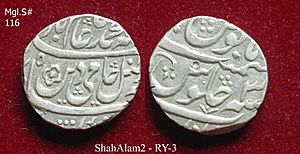
After the defeats at Muzaffargarh and Ghanaur, Majad-ud-Daula was arrested by Shah Alam II's orders. Shah Alam II then called back Mirza Najaf Khan. Majad-ud-Daula was arrested for making mistakes and working with the emperor's enemies. He was put in prison, and two million dam of stolen money was recovered from him. Shah Alam II's poor decisions led to his own downfall.
Mirza Najaf Khan had given the Mughal Empire a chance to recover by building a strong, well-managed army. In 1779, the new Mughal Army decisively defeated Zabita Khan. The rebels lost 5,000 men and did not return during Mirza Najaf Khan's life. Sadly, after the general's death, Shah Alam's bad judgment continued. Mirza Shafi, Najaf Khan's nephew, who had proven his bravery, was not made commander-in-chief. Instead, Shah Alam II appointed people who were not loyal and whose records were not good. They soon started fighting over small things. Even the corrupt former chief minister, Majad-ud-Daula, was given his old job back. He later worked with the Sikhs and reduced the size of the Mughal Army from over 20,000 to only 5,000. This left Emperor Shah Alam II helpless against his enemies.
Prisoner of Ghulam Qadir
Nawab Majad-ud-Daula was followed by Ghulam Qadir, a known enemy of the Mughals and grandson of Najib Khan. Ghulam Qadir, with his Sikh allies, forced Shah Alam II to make him the chief minister of the Mughal Empire. Ghulam Qadir ransacked the palaces, looking for Mughal treasure. He believed it was worth 250 million rupees.
He could not find such a large amount. Angered by the emperor's attempts to get rid of him, Ghulam Qadir himself blinded Shah Alam II on August 10, 1788. Ghulam Qadir treated the emperor and his family very cruelly. After ten weeks, Mahadaji Shinde stepped in. He killed Ghulam Qadir and took control of Delhi on October 2, 1788. He put Shah Alam II back on the throne and became his protector. Mahadaji Shinde sent Ghulam Qadir's ears and eyes to Shah Alam.
Client of Mahadji Shinde
Shah Alam II was grateful for Mahadaji Shinde's help. He gave him the titles Vakil-ul-Mutlaq (Regent of the Empire) and Amir-ul-Amara (Head of the Nobles). He made a deal with the Peshwa, agreeing to pay tribute to Pune in return for the protection given by Mahadji Shinde of the Maratha Confederacy.
After killing Ghulam Qadir and putting Shah Alam II back on the throne, a Maratha army stayed in Delhi permanently from 1788. They ruled northern India for the next two decades. The East India Company took over from them after the Second Anglo-Maratha War in 1803.
Arrival of British Troops
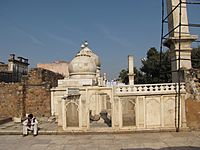
The British worried about the French threat in Europe and how it might affect India. They wanted to regain control over Shah Alam II. The British feared that French military officers might overthrow the Marathas. They thought the French could then use the Mughal emperor's authority to achieve their goals in India.
Shah Alam II also communicated with Hyder Ali and later his son Tipu Sultan. This was during their conflicts with the East India Company in the Anglo-Mysore Wars. He was very aware of the British plans to expand their power.
After the Battle of Delhi (1803) during the Second Anglo-Maratha War, British troops entered Delhi on September 14, 1803. This ended the Maratha rule over the Mughals. Shah Alam, who was then an old, blind man, was placed under British protection. The Mughal Emperor no longer had military power, but he was still respected as a member of the House of Timur throughout the country. Local rulers still sought his formal approval and valued the titles he gave them. They made coins and read Friday sermons in his name. In 1804, the Marathas under Yashwantrao Holkar tried to take Delhi from the British in the Siege of Delhi (1804), but they failed.
Death
Shah Alam II died naturally on November 19, 1806.
His grave is in a marble enclosure next to the Moti Masjid. This is near the tomb of the 13th-century Sufi saint Qutbuddin Bakhtiar Kaki, in Mehrauli, Delhi. The tombs of Bahadur Shah I (also known as Shah Alam I) and Akbar Shah II are also in this enclosure.
Images for kids
-
Mughal era illustration of Pir Ghazi of Bengal, during the 18th century.
-
Pierre André de Suffren ally of Hyder Ali and also Shah Alam II.
-
Hyder Ali was bestowed the title Shams ul-Mulk and Amir ud-Daula by Shah Alam II, his pro-French policies were a continuation of the Mughal Empire's policies during the Seven Years' War.
-
Map of India in 1765, before the fall of Nawabs and Princely states nominally allied to the emperor (mainly in Green).
-
Blind Mughal Emperor Shah Alam II sits at throne of Delhi
See also
 In Spanish: Alam II para niños
In Spanish: Alam II para niños
- Mirza Najaf Khan
- Shuja-ud-Daula
- Hyder Ali
- Muhammed Ali Khan Wallajah



